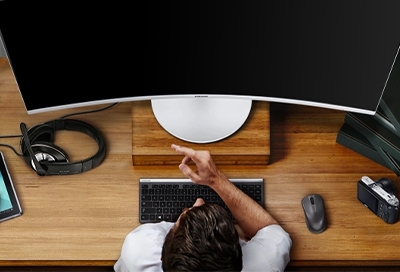A Samsung monitor not turning on with a blue light might indicate a power issue or a faulty connection. Ensure all cables are securely connected.
Samsung monitors are known for their quality, but sometimes issues arise. One common problem users face is the monitor not turning on despite the blue light being on. This can be frustrating, especially when you need to get work done.
Understanding the potential causes can help you troubleshoot the issue efficiently. It could be due to a loose power cable, an issue with the power strip, or a problem with the monitor itself. Before seeking professional help, try checking and securing all connections. This simple step can often resolve the problem without further hassle.

Credit: www.samsung.com
Common Issues
Is your Samsung monitor showing a blue light but not turning on? This is a common issue faced by many users. Understanding the root causes can help you troubleshoot effectively.
Power Supply Problems
One of the main reasons your Samsung monitor may not turn on is due to power supply problems. Here are a few things to check:
- Ensure the power cable is securely connected to the monitor.
- Check if the power outlet is functional by plugging in another device.
- Inspect the power adapter for any visible damage.
If the power supply is faulty, consider replacing it with a new one. Always use the original power adapter to avoid compatibility issues.
Cable Connection Issues
Cable connection issues can also prevent your monitor from turning on. Verify the following connections:
- Make sure the HDMI or DisplayPort cable is properly connected.
- Check for any bent or damaged pins in the cable connectors.
- Try using a different cable to rule out any cable-specific problems.
Sometimes, simply reconnecting the cables can solve the issue. Ensure all connections are snug and secure.
Initial Troubleshooting
If your Samsung monitor is not turning on, try these initial troubleshooting steps. These steps are simple and can save you time and frustration. Let’s start with the basics.
Check Power Button
First, check the power button on your Samsung monitor. Ensure it is pressed firmly. Sometimes, the power button can be stuck or not fully pressed. This can prevent the monitor from turning on.
If the power button feels loose, it might be broken. In this case, you may need a repair. Also, verify that the power button light is on. If it is not, there might be a power issue.
Inspect Power Cord
Next, inspect the power cord. Make sure it is properly connected to both the monitor and the power outlet. A loose connection can prevent your monitor from receiving power.
Check for any visible damage on the power cord. Look for cuts, frays, or exposed wires. If you find any damage, replace the power cord immediately. A damaged cord can be a fire hazard.
Use a different power outlet to test the cord. Sometimes, the issue is with the outlet itself. If the monitor still does not turn on, try using a different power cord if available.
| Step | Action |
|---|---|
| 1 | Check power button |
| 2 | Inspect power cord |
| 3 | Use a different power outlet |
| 4 | Try a different power cord |
By following these steps, you can quickly identify common issues. If your Samsung monitor still does not turn on, you might need professional help.
Power Supply Solutions
Experiencing issues with your Samsung monitor not turning on blue light? The problem might lie in your power supply. Power supply issues are common but often overlooked. Here, we provide simple solutions to troubleshoot and fix power supply problems.
Test With Another Device
First, check if the power supply is working. Plug in another device, like a lamp or phone charger, into the same outlet. This helps determine if the outlet is faulty.
If the other device works, the issue may be with the monitor or its power cable. If the other device doesn’t work, the outlet might be the problem.
Use A Different Outlet
Sometimes, an electrical outlet can be faulty. Try plugging your Samsung monitor into a different outlet.
If the monitor turns on, the original outlet is likely the issue. Consider having an electrician inspect it.
If the monitor still doesn’t turn on, the problem may lie elsewhere, possibly in the monitor itself or its power cable.
Cable And Connection Fixes
Your Samsung monitor is not turning on. The blue light is on but no display. One common cause is the cable connection. Fixing the cable connections can solve the issue. Here are some steps to follow.
Secure Cable Connections
First, ensure all cables are securely connected. Check the power cable and video cable. A loose cable can cause the monitor to not turn on. Follow these steps:
- Turn off your monitor and computer.
- Unplug the power cable from the monitor.
- Unplug the video cable from the monitor and computer.
- Inspect the cables for any visible damage.
- Reconnect the power cable to the monitor.
- Reconnect the video cable to both the monitor and computer.
- Turn on your monitor and computer.
Make sure each connection is firm and secure. Loose connections often cause display issues.
Replace Faulty Cables
If securing the cables doesn’t work, the cables might be faulty. Replace the faulty cables to fix the issue. Here’s how you can do it:
| Step | Action |
|---|---|
| 1 | Turn off your monitor and computer. |
| 2 | Unplug the power cable and video cable. |
| 3 | Purchase a new power cable and video cable. |
| 4 | Connect the new power cable to the monitor. |
| 5 | Connect the new video cable to both monitor and computer. |
| 6 | Turn on your monitor and computer. |
Using new cables ensures a stable connection. This can solve the display problem. Faulty cables are a common issue.
Monitor Reset
Experiencing issues with your Samsung monitor not turning on? A monitor reset can often resolve the problem. This process can help refresh the monitor’s settings and clear any glitches. Below are two methods to reset your Samsung monitor: Unplug and Replug, and Factory Reset.
Unplug And Replug
The first step in troubleshooting is to unplug the monitor. Follow these steps:
- Turn off your monitor.
- Unplug the power cable from the outlet.
- Wait for at least 30 seconds.
- Replug the power cable into the outlet.
- Turn on your monitor.
This simple action can sometimes resolve power issues. If your monitor still doesn’t turn on, try a factory reset.
Factory Reset
A factory reset can restore your monitor to its original settings. This can clear any settings causing the issue. Follow these steps to perform a factory reset:
- Turn on the monitor.
- Press the Menu button on the monitor.
- Navigate to the “Settings” option using the arrow keys.
- Select “Factory Reset” from the menu.
- Confirm the reset by pressing the appropriate button.
Your monitor will restart and return to its original settings. This process can resolve many common issues. If the problem persists, consider contacting Samsung support.
Firmware Updates
Updating your Samsung monitor’s firmware can solve the issue of it not turning on. Firmware updates improve performance and fix bugs. Follow the steps below to ensure your monitor runs smoothly.
Download Latest Firmware
First, you need to download the latest firmware. Visit the Samsung Support website. Enter your monitor model number. Click on the firmware download link.
Make sure to save the file to a USB drive. This will make it easy to install on your monitor. Ensure the USB drive is formatted to FAT32. An unformatted drive may cause errors.
Update Monitor Software
Next, insert the USB drive into your monitor. Turn on the monitor if possible. Press the Menu button on your monitor. Navigate to Support and select Software Update.
Choose Update Now. The monitor will read the USB drive. Follow the on-screen instructions to complete the update. Do not turn off the monitor during the update process.
After the update, your monitor should restart. Check if the blue light issue is resolved. If not, consider contacting Samsung Support for further assistance.
| Step | Action |
|---|---|
| 1 | Download firmware from Samsung Support |
| 2 | Save file to FAT32 USB drive |
| 3 | Insert USB into monitor |
| 4 | Navigate to Software Update |
| 5 | Select Update Now |
Updating the firmware can often solve common issues. Always ensure your monitor is up-to-date. This keeps it running smoothly and efficiently.
Hardware Inspection
Experiencing issues with your Samsung monitor not turning on? A thorough hardware inspection can help. Below, we’ll guide you through essential steps to diagnose the problem.
Check For Physical Damage
Start by checking for any visible physical damage on your monitor. Look for:
- Cracks on the screen
- Broken buttons
- Loose or damaged cables
Inspect the power cord and HDMI cables. Make sure they are not frayed. Ensure all connections are secure. If you see any damage, replacing the cables might solve the issue.
Inspect Internal Components
If no external damage is found, it might be an internal component issue. Here’s how to proceed:
- Unplug the monitor and remove the back cover carefully.
- Check the internal power supply board for burnt or damaged parts.
- Inspect the capacitors. Look for bulging or leaking capacitors.
- Examine the internal cables. Ensure they are properly connected.
If you notice any damaged components, consider consulting a professional. Replacing faulty parts can often restore the monitor.
Regular hardware inspections can prevent more significant issues. Always handle electronic components with care. Remember to power off and unplug the monitor before inspecting.
External Device Interference
Sometimes, your Samsung monitor won’t turn on due to external device interference. External devices can create conflicts. This can disrupt the monitor’s normal operations. Follow these steps to resolve the issue.
Disconnect External Devices
First, disconnect all external devices from your Samsung monitor. This includes:
- Keyboards
- Mice
- USB drives
- External hard drives
Disconnecting these devices helps identify if one is causing the problem. Once disconnected, try turning on the monitor again.
Test Without Peripherals
Next, test the monitor without any peripherals. This means:
- Remove all connected devices
- Leave only the power cable connected
Turn on your monitor. If it powers on, reconnect each device one by one. This helps identify the problematic device.
If the monitor still does not turn on, the issue may lie elsewhere. Consider checking the power source or contacting Samsung support.
Professional Repair
Sometimes, a Samsung monitor might not turn on despite all efforts. In such cases, professional repair is essential. Trained technicians can diagnose and resolve complex issues efficiently. Below are some steps to seek professional help.
Contact Samsung Support
Contacting Samsung Support is the first step. Their team can provide guidance and troubleshooting tips. They may also determine if your monitor needs a repair.
- Visit the official Samsung Support website.
- Locate the support section for monitors.
- Use live chat or call their support number.
Ensure you have your monitor’s model number handy. This helps the support team assist you quickly.
Visit Authorized Service Center
If your monitor needs repairs, visit an authorized service center. Authorized centers have certified technicians and genuine parts. This ensures high-quality service and maintains your warranty.
| Steps | Details |
|---|---|
| 1 | Locate the nearest authorized service center on the Samsung website. |
| 2 | Call and book an appointment. |
| 3 | Take your monitor and proof of purchase to the center. |
Technicians will inspect your monitor and provide a repair estimate. They will fix your monitor using genuine Samsung parts, ensuring quality and longevity.

Credit: www.reddit.com
Preventive Tips
Ensuring your Samsung monitor operates smoothly involves following some preventive tips. Regular maintenance and proper usage can prevent many common issues. Here are some helpful tips to keep your monitor in top condition.
Regular Maintenance
Regular maintenance is crucial for the longevity of your Samsung monitor. Dust and debris can accumulate over time, causing various issues. Here are some steps for regular maintenance:
- Clean the screen: Use a microfiber cloth to clean the screen gently.
- Check cables: Ensure all cables are securely connected and in good condition.
- Update firmware: Check for firmware updates and install them regularly.
Perform these tasks monthly to maintain your monitor’s health.
Use Surge Protectors
Power surges can damage electronic devices, including monitors. Using surge protectors is a simple yet effective way to protect your Samsung monitor. Here are some benefits:
- Protects from power spikes: Surge protectors shield your monitor from sudden power spikes.
- Increases lifespan: Reduces the risk of electrical damage, extending your monitor’s life.
- Multiple outlets: Allows you to connect multiple devices safely.
Invest in a quality surge protector to safeguard your monitor and other electronics.

Credit: m.youtube.com
Frequently Asked Questions
Why Is My Samsung Monitor Not Turning On?
Your Samsung monitor might not turn on due to loose connections, a faulty power cable, or a damaged power supply. Ensure all cables are securely connected and try using a different power outlet. If the issue persists, contact Samsung support for further assistance.
What Does The Blue Light On My Samsung Monitor Mean?
The blue light on your Samsung monitor indicates that it is powered on and functioning properly.
Why Is My Samsung Monitor On But The Screen Is Black?
Your Samsung monitor might have a loose cable, outdated drivers, or incorrect input source. Check connections and update drivers.
Conclusion
Resolving your Samsung monitor’s blue light issue can be straightforward. Follow the troubleshooting steps outlined in the guide. Ensuring proper connections and settings can often fix the problem. If issues persist, professional help may be needed. Keep your monitor in optimal condition for the best performance and longevity.

Hello Good People! This is Pavel and Welcome to PC Delight!
I’m an Electronics Engineer by profession with a passion for Gaming & PC builds. When I came up with the idea for PC Delight, it was my goal to share & offer the very best PC building ideas to tech-loving people like myself.
Since my school days, I’ve been just addicted to gaming & PCs. That leads me to experiment with various ways around the very niche, resulting in great productivity. And I’m here to share those practical experiences. So that next time you start some experiment with your PC builds or struggle to cope with a certain game, I’m here with the solutions. With these philosophies, I started my journey in 2017 and just kept going.